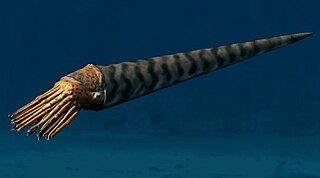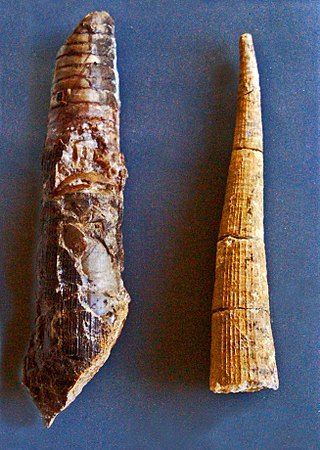Related Research Articles

Orthocerida, also known as the Michelinocerida, is an order of extinct orthoceratoid cephalopods that lived from the Early Ordovician possibly to the Late Triassic. A fossil found in the Caucasus suggests they may even have survived until the Early Cretaceous, and the Eocene fossil Antarcticeras is sometimes considered a descendant of the orthocerids although this is disputed. They were most common however from the Ordovician to the Devonian.

Lamellorthoceratidae is a family of fossil orthoceratoids in the Orthocerida, defined by Curt Teichert in 1961. The lamellorthoceratids are placed in the superfamily Orthocerataceae in the Treatise on Invertebrate Paleontology.

Pseudorthocerida is an order of generally straight longiconic orthoceratoids with a subcentral to marginal cyrtochoanitic siphuncle composed of variably expanded segments which may contain internal deposits that may develop into a continuous parietal lining.. Cameral deposits are common and concentrated ventrally. Apices typically have a slight to moderate exogastric curvature
Pseudactinoceras is an extinct nautiloid cephalopod included in the order Pseudorthocerida and the namesake of the family Pseudactinoceratidae.

Kionoceras is an extinct nautiloid cephalopod genus included in the orthocerid family Kionoceratidae with scattered worldwide distribution from the Middle Ordovician to the Lower Permian. Kionoceratids are orthocerids with prominent longitudinal ornamentation on their shells, sometimes augmented by secondary transverse ornamentation. Orthocerids are, of course, prehistoric nautiloides with generally straight and elongate shells, mostly with central or subcentral siphuncles.

Geisonoceratidae is an extinct family of orthoceroid cephalopods endemic to what would be Asia, Europe, and North America from the Middle Ordovician to the Middle Devonian living from about 470—380 mya, existing for approximately 90 million years. With the possible addition of an Early Cretaceous orthocerid from the western Caucasus the range of this group increases dramatically to some 350 million years, thus making it one of the longest lived families of the Nautiloidea.

Paraphragmitidae is an extinct family of actively mobile aquatic carnivorous cephalopods belonging to the subclass Orthoceratoidea endemic to what would be Asia and Europe during the Silurian living from 436 to 418.7 mya, existing for approximately 17.3 million years.

The Phragmoceratidae is a family of extinct nautiloid cephalopods from the Order Discosorida that lived during the latter part of the Silurian.
The Orthocerataceae is a superfamily of orthocerid cephalopods that lived from the late Early Ordovician to the Early Cretaceous, but is no longer in general use.

Troedssonellidae is a family of orthoceroid cephalopods from the Ordovician, derived from rod-bearing Baltoceratidae, that have a continuous lining within the siphuncle that resembles very thin and slender endocones. Shells are generally slender and orthoconic. The siphuncle is central or subcentral, composed of straight or slightly expanded segments. Septal necks generally short and connecting rings are thin. Thin cameral deposits are known, which along with the position of the siphuncle and thin connecting rings distinguishes them from the endocerids in which they have been included.
Jaochimoceras is a genus of orthoceroid cephalopods from the Silurian of Central Europe (Bohemia) named by Baskov, 1960, and included in the Geisonoceratidae. As with the orthocerids, its shell is longiconic, siphuncle more or less central, and chambers somewhat long.
Balticoceras is a genus in the Orthocerid family, Orthoceratidae, from the Upper Ordovician of Estonia, closely related to Michelinoceras. Balticoceras is distinguished by its straight shells with a subcircular cross section, broadly flattened ventrally and evenly rounded dorsally, and by its marginal, orthochoanitic siphuncle. Balticoceras which is included in the subfamily Michelinoceratinae along with Michelinoceras should not be confused with Baltoceras which belongs in the Ellesmerocerida.

Plagiostomoceras is an orthocerid cephalopod from the lower Paleozoic of Europe and Australia.
Bitaunioceras is a genus of Permian orthocerids with a gradually expanding, straight, orthodontic shell with straight transverse sutures and a small, subcentral siphuncle with straight tubular orthochromatic necks.
Hesperoceras is an orthocerid cephalopod belonging to the subfamily Michelinoceratinae which comes from the lower Mississippian of New Mexico.
Polygrammoceras is an orthoconic nautiloid that lived during the period from the middle Ordovician to the early Devonian in what is now North America and Eurasia.
Sceptrites is an orthoceratoid genus contained within the pseudorthocerid family Spyroceratidae known by its slightly compressed, possibly endogastrically curved, cyrtoconic shell. Sceptrites has been found in Devonian sediments in Ohio and N.Y. in the United States and in Victoria, Australia.

Geisonoceras is an extinct orthocerid genus named by Hyatt, 1884, and type for the Geisonoceratidae established by Zhuravleva in 1959.
Dolorthoceras is a nautiloid cephalopod from the upper Paleozoic found in Lower Devonian to Lower Permian strata in North America, Europe, Asia, and Australia.
Chicagooceras is a genus of orthocerids from the Silurian of North America.
References
- Walter C. Sweet, 1964. Nautilodea - Orthocerida. Treatise on Invertebrate Paleontology Part K, Mollusca 3. Geological Society of America and University of Kansas Press.
- Paleobiology Database Paleocycloceras entry
- Paleobiology Database Ctenoceras entry